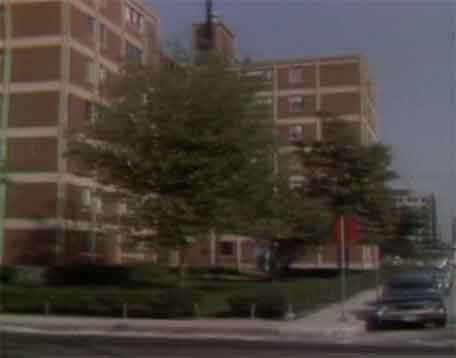 "Good Times" public housing, above, was more "dramedy" than reality.
"Good Times" public housing, above, was more "dramedy" than reality.
Rep. Alexandria Ocasio-Cortez and Sen. Bernie Sanders have been pushing for renewed federal investment in public housing and to repeal the Faircloth Amendment, which prevents cities from using federal housing dollars on the construction of new publicly owned units. The research director of the Urban Institute's Land Use Lab is advising policymakers to "reconsider an obvious but long-taboo solution: building new public housing."
It's taboo, of course, because the image of existing public housing in the U.S. is deservedly terrible. Proponents like to talk instead about places such as Singapore and Vienna, two cities that have a reputation for creating high-quality, publicly owned units that accommodate middle-class and poor residents. Vienna was recently described in the New York Times Magazine as a "renters' utopia," with the city's public housing units granted pride of place.
To the extent that this talk helps get the left to see that the affordability of housing is in large part a function of the supply of housing, it's all to the good. What the discussion is overlooking, however, are the astronomical costs of public-sector construction in the US.
Consider the fast-growing city of Austin, Texas, which reasonably wants to add to its mass-transit capacity with a new train line. Thanks to soaring cost projections, it has given up on the idea of digging a tunnel beneath downtown. Instead, the plan is for a 9.8-mile surface route with an average travel speed of 15 miles per hour and a projected cost of $4.5 billion. By contrast, Milan, is nearing completion of a new line of its metro system. It's 9.3 miles long, completely underground, has six stations with transfers to other metro or commuter rail lines, and is built to use fully automatic driverless trains to keep long-term operating costs down.
The cost? About €1.7 billion - less than half the price in Austin, and for a far superior project.
And it's not just mass transit. Highway construction costs have been rising faster than inflation for a generation , but have absolutely exploded in recent years. One recent study found a 50% increase in road-building costs over a span of just two years. High materials prices, high labor costs and a big increase in federal infrastructure funding are breaking the system.
The City of Los Angeles was viciously mocked recently for excitedly unveiling "La Sombrita," a small fixture to add to bus-stop posts that will supposedly provide shade in the day and light at night - at a cost of $10,000 per fixture. This is, remarkably, an economizing measure in a city where a traditional bus shelter can cost $50,000.
It's sobering that these problems seem to be getting worse even as attention to them is increasing. The study showing the long-term increase in highway construction costs was co-authored by Zachary Liscow, who is chief economist at the Office of Management and Budget. Transportation Secretary Pete Buttigieg took office talking a good game about construction costs, but not only has the price tag for conventional projects deteriorated, there are also serious questions about whether Biden's high-speed rail ambitions can survive contact with his Buy America contracting rules, since the most cost-effective path to train-related procurement is to buy stuff from foreign countries with larger and more modern passenger rail systems.
These are all deeply serious problems in need of solutions: If the government doesn't build highways and bus shelters and train lines, nobody else is going to. A great nation needs great infrastructure, which requires both public funding and cost-effective construction methods.
But housing? In a country where every level of government is strapped for cash, and where budgets for even the most plausible and necessary projects seem to be exploding, how does it make sense for the government to build things that the private sector is willing to do? Both Singapore and Vienna launched their investments in public housing at times when the private market lacked confidence that investing in construction would pay off. Both cities built publicly financed apartment buildings as a way of investing in themselves at a time when private markets didn't want to.
The United States, whatever its problems, does not lack for developers, contractors and entrepreneurs who are willing to finance home construction when they are allowed to do so. What stands in their way is a dizzying array of rules and regulations - designed, for the most part, to prevent new construction.
In New York, the state legislature recently rejected a proposal to alter zoning rules when a minority of Democrats joined with most Republicans to stand up for local control. In Texas, the state legislature rejected a proposal to alter zoning rules when a minority of Republicans joined with most Democrats to stand up for local control. The good news is the housing reform movement has had successes lately in states such as Washington and Montana.
One criticism of the YIMBY vs. NIMBY debate is that it fails to emphasize public housing. As someone who has been arguing for more sensible zoning regulations for more than a decade, I'm not going to pretend that the debate doesn't get tiresome. But it would be wrong to say that it isn't vital. How best to enable citizens to provide shelter for themselves is a core issue for any society.
It would make sense for the government to build public housing if it could prove that it was good at building stuff efficiently. But that's a hard case to make. Until the U.S. can figure out a way to build the things it needs the government to build, and at a reasonable price, why not simply allow the private sector to build more housing?
(COMMENT, BELOW)
Previously:
• 05/09/23: Football stadiums belong in the suburbs
• 05/02/23: Only Mitch McConnell can save the US from default
• 02/15/23: Biden's building boom will be needlessly expensive
• 01/25/23: Manchin's plan to avert a debt crisis just might work
• 01/10/23: George Santos doesn't deserve to be kicked out of Congress
• 10/03/22 Ron DeSantis and the rise of free-lunch conservatism
• 09/07/22 A debate over the deficit is just what America needs
• 09/03/22 College tuition is too high, but it isn't actually rising
• 08/02/22 Dems need more Manchins
• 06/30/22 Biden 2024? America needs to know now
• 05/30/22 The flaw in the progressive stance on guns
• 05/18/22 Biden can do much more to fight inflation
• 04/05/22 We'll miss globalization when it's gone
• 12/27/21 How 2021 could have been different for Biden
• 11/09/21 Where have you gone, Joe Biden of the primaries?
• 10/05/21What Dems need: More short-term thinking
• 06/02/21
Shh, Congress IS working
Matthew Yglesias writes the Slow Boring blog and newsletter. A co-founder of Vox and a former columnist for Slate, he is also host of "The Weeds" podcast and is the author, most recently, of "One Billion Americans."


 Contact The Editor
Contact The Editor
 Articles By This Author
Articles By This Author